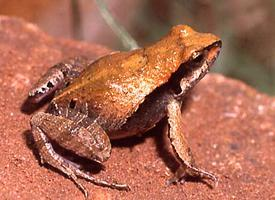
Greutăți și măsuri
| Lungime | de la 10 la 20 cm |
|---|
Starea de conservare
| Amenințat |
Descrierea animalului
The Surinam horned frog (Ceratophrys cornuta), also commonly referred to as the Amazonian horned frog or simply the horned frog, is a fascinating and somewhat formidable amphibian native to the rainforests of South America, particularly found in Suriname, Brazil, Colombia, and Venezuela. This species belongs to the family Ceratophryidae and is well-known for its distinctive physical appearance and predatory behavior.One of the most striking features of the Surinam horned frog is its size. These frogs are quite large, with some individuals reaching lengths of up to 20 centimeters (about 8 inches). Their robust and somewhat flattened bodies are adapted to a life spent mostly within the leaf litter of the forest floor, blending in perfectly with the surrounding environment thanks to their vivid and variable coloration, which ranges from bright green to brown with various markings that mimic the appearance of leaves and moss.
The name "horned frog" comes from the presence of fleshy projections above the eyes, which resemble horns. These "horns" give the frog a formidable appearance and may serve to intimidate predators or rivals. The frog's large mouth, which can open wide enough to engulf prey almost as big as itself, including insects, other frogs, and even small mammals and birds, is another distinctive feature. The Surinam horned frog employs a sit-and-wait strategy, remaining motionless for long periods until an unsuspecting prey comes within striking distance. It then launches a swift and deadly attack, using its powerful hind legs to leap forward if necessary.
The skin of the Surinam horned frog is thick and textured, providing camouflage and protection against predators and the elements. This species is also known for its vocalizations; males emit loud, deep calls to attract females during the breeding season. These calls can be heard emanating from the forest floor after heavy rains, which stimulate the frogs' breeding instincts.
Reproduction in Surinam horned frogs involves the laying of eggs in temporary pools formed by rainwater. The female deposits a large clutch of eggs, which the male then fertilizes externally. The tadpoles that emerge from these eggs are voracious eaters, consuming algae and detritus in the water. As they grow, they undergo a remarkable transformation, developing limbs and reabsorbing their tails before emerging as fully formed frogs.
Despite their fearsome appearance and predatory nature, Surinam horned frogs are increasingly popular in the pet trade. However, potential owners should be aware that these creatures require specific care, including a diet that mimics their natural predatory habits and an environment that replicates their rainforest habitat. Moreover, their conservation status, while currently not classified as endangered, could be threatened by habitat destruction and the effects of climate change, making the preservation of their natural habitats critical for their continued survival.
In summary, the Surinam horned frog is a remarkable creature that embodies the diversity and complexity of South America's rainforest ecosystem. Its unique adaptations, striking appearance, and fascinating behaviors make it a subject of interest for scientists, nature enthusiasts, and the pet trade alike, underscoring the importance of conservation efforts to ensure its survival for generations to come.
Animale similare
Fotografii noi cu animale
Top 10 animale
- Diana monkey (Cercopithecus diana)
- Dolphin gull (Leucophaeus scoresbii)
- Galápagos tortoise (Geochelone nigra complex)
- Moustached guenon (Cercopithecus cephus)
- Japanese spider crab (Macrocheira kaempferi)
- Colossal squid (Mesonychoteuthis hamiltoni)
- Fox tapeworm (Echinococcus multilocularis)
- Stone loach (Barbatula barbatula)
- Japanese macaque (Macaca fuscata)
- Barbary macaque (Macaca sylvanus)
